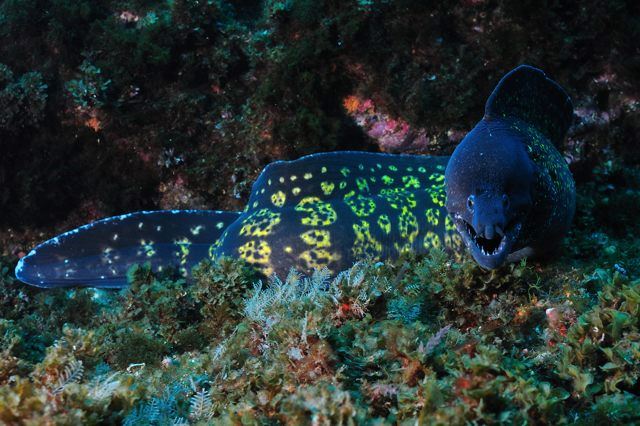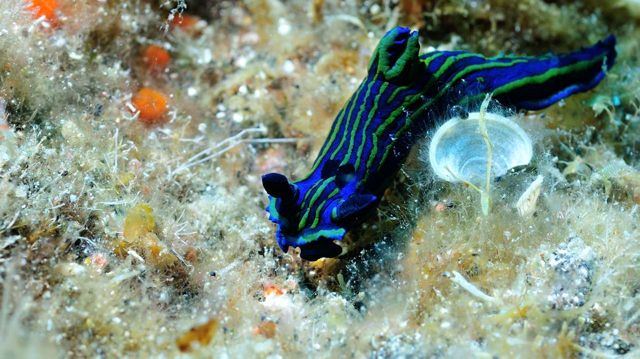The three Azorean islands of Pico, Faial and S. Jorge - often called the Triangle - offer some exciting coastal and near shore diving.
Set in the middle of the North Atlantic ocean, the islands lie within a complex circulation of ocean currents that include the Gulf Stream as well as the North Atlantic and Azores currents.
Narrow coastal shelves, submarine walls, canyons and escarpments bring coastal, pelagic and deep water marine ecosystems in close proximity to each other.
As a consequence, on a dive, quite literally, almost anything could turn up!

A Monkfish (Lophius piscatorius) takes a rest in the shallows - photo by Justin Hart.
Pico is the youngest island at just around 300,000 years old.
Its huge strato-volcano dominates the skyline and its coastline still remains rugged and wild. Where the island's more recent lava beds meet the sea, Atlantic storms have etched steep cliffs and an exciting seascape of caves, arcades, ridges and drop offs. These places are often best explored by boat but many protected bays and ports also offer excellent places to dive from shore.

A shoal of Trigger fish (Balistes capriscus) - photo by Justin Hart
The islands are so young that their coastal habitats are still being colonised by marine life.
Most species originate from the European, Mediterranean and African continental shelves but some have also come from the western Atlantic too.
There has been little time for endemism to evolve in the near shore habitats and only two of 116 species of coastal fish are thought to occur only in the Azores, the Blue Wrasse (Centrolabrus caerulus) and the Azores scorpion fish(Scorpaena azorica).

Azores scorpion fish - Photo by Justin Hart
Nevertheless, the coastal fish assemblage is well augmented by the addition of some exciting pelagic and deep water fish as well as marine invertebrates and occasionally sea turtles.
More than 20 species of whale and dolphins also reside or regularly pass by the islands, although divers will need to join a whale watching trip to see them, as they rarely approach close to shore.

The endemic Blue wrasse (Centrolabrus caeruleus) - photo by Justin Hart.
It is often difficult to predict what can be seen during our coastal dives because of the proximity of so many diverse habitats. However, it is possible to target some species by diving specific habitats at certain times of the year or states of the tide.

A Round stingray - females can grow near 2m wide
For example, sandy habitats are good for Common stingrays (Dasyatis pastinaca), Thornback rays (Raja clavata), Cleaver wrasse (Xyrichthys novacula) and Black-spot conger eels (Paraconger macrops).

Black-spot conger eel
Rocky reefs yield abundant moray eels (4 species) and groupers. Places that pinch the current also attract huge Round stingrays (Taeniura grabata) (particularly in June, when males and females sometimes gather together) but also the chance to see barracuda, jacks and even tunas.

Brown moray -photo by Justin Hart

Mediterranean moray -photo by Justin Hart

Black moray -photo by Justin Hart
Escarpments and pinnacles are exciting spots for pelagics such as eagle rays (Myliobatis aquila), tunas, jacks, Bluefish (Pomatomus saltator) and, in late summer, perhaps Wahoo (Acanthocybium solandri), mobulas and mantas.

Island grouper - photo by Justin Hart
Sharks are rarely seen near shore. To see sharks in the Azores, we recommend our special and highly successful shark diving trips for the Blue sharks (Prionace glauca) and Makos (Isurus oxyrinchus).
Nevertheless, in late spring and early summer some shore divers may get lucky and see a Tope (Galeorhinus galeus), which come close to shore at this time of year to pup or even a Hammerhead shark (Sphyrna zygaena) perhaps at anytime.
Underwater photographers interested in critters or small marine life can be entertained by a diverse range of blennies, gobies, small wrasse, damsels, scorpion fish, nudibranchs, crustacea and a variety of sessile marine invertebrates (including Black corals Antipathella wollastoni in water as shallow as 18m!).

Huge lobster and diver
Nudibranchs are best seen in late spring and early summer. The most often seen species include the psychodelic Tambje ceutae, Hypselodoris picta (often seen among beds of orange sponge) Crambe crambe and Jewel anemones Corynactis viridis, Discodoris atromaculata and the large Sea hare Aplysia fasciata.

The psichedelic nudibranch Tambje ceutae
Pico's arcades, caverns, drifts, deep drop offs and seamounts provide an exciting seascape to see much of her marine life. However, protected bays and ports are also worth exploring as they provide safe nursery habitats for many fish species.
Young jacks, barracuda and Derbio (Trachinotus ovatus) can regularly be seen hunting among the shoals of smaller fish.

Common octopus - photo by Justin Hart
Octopus also lurk among the rocks and scavenge discards from the artisanal fishermen. These places are great for dive training or for divers to begin or renew their sea diving adventures.
Few places in the world offer such a diverse marine life experience.
If you are looking for an alternative place to dive outside the tropics and within Europe, there is nowhere better.
Join us!